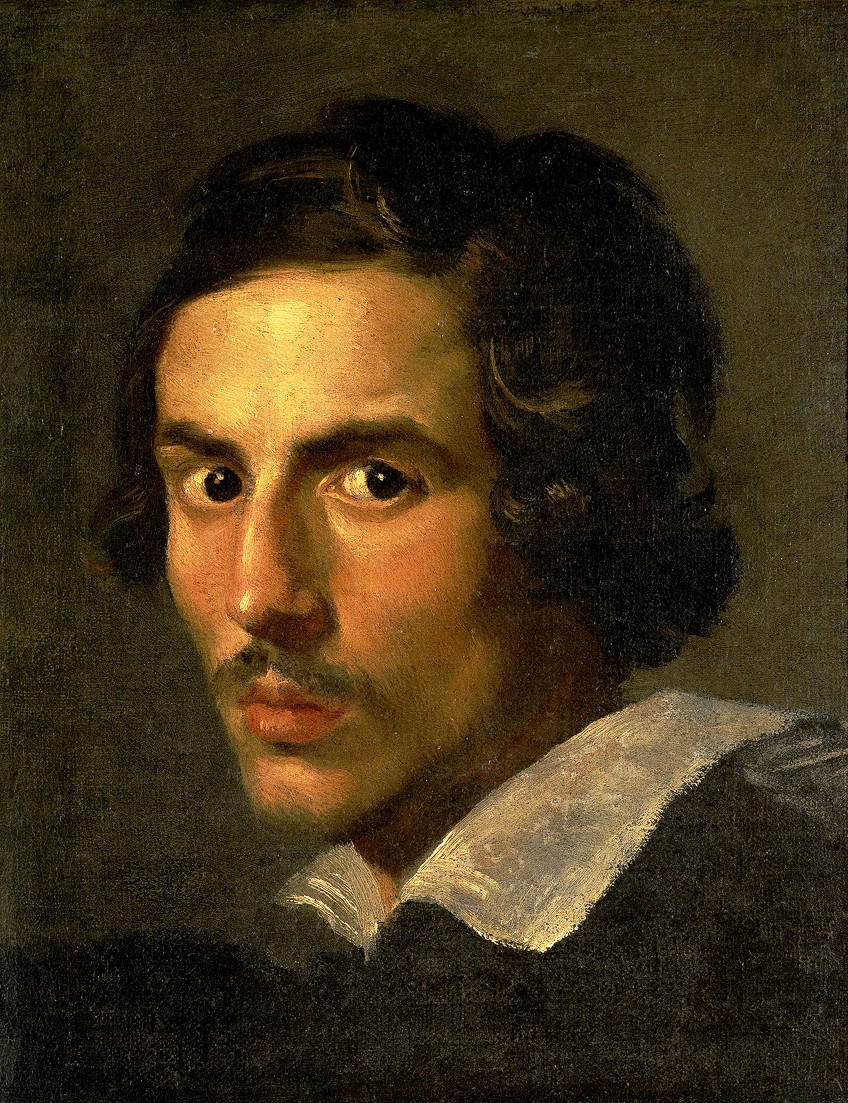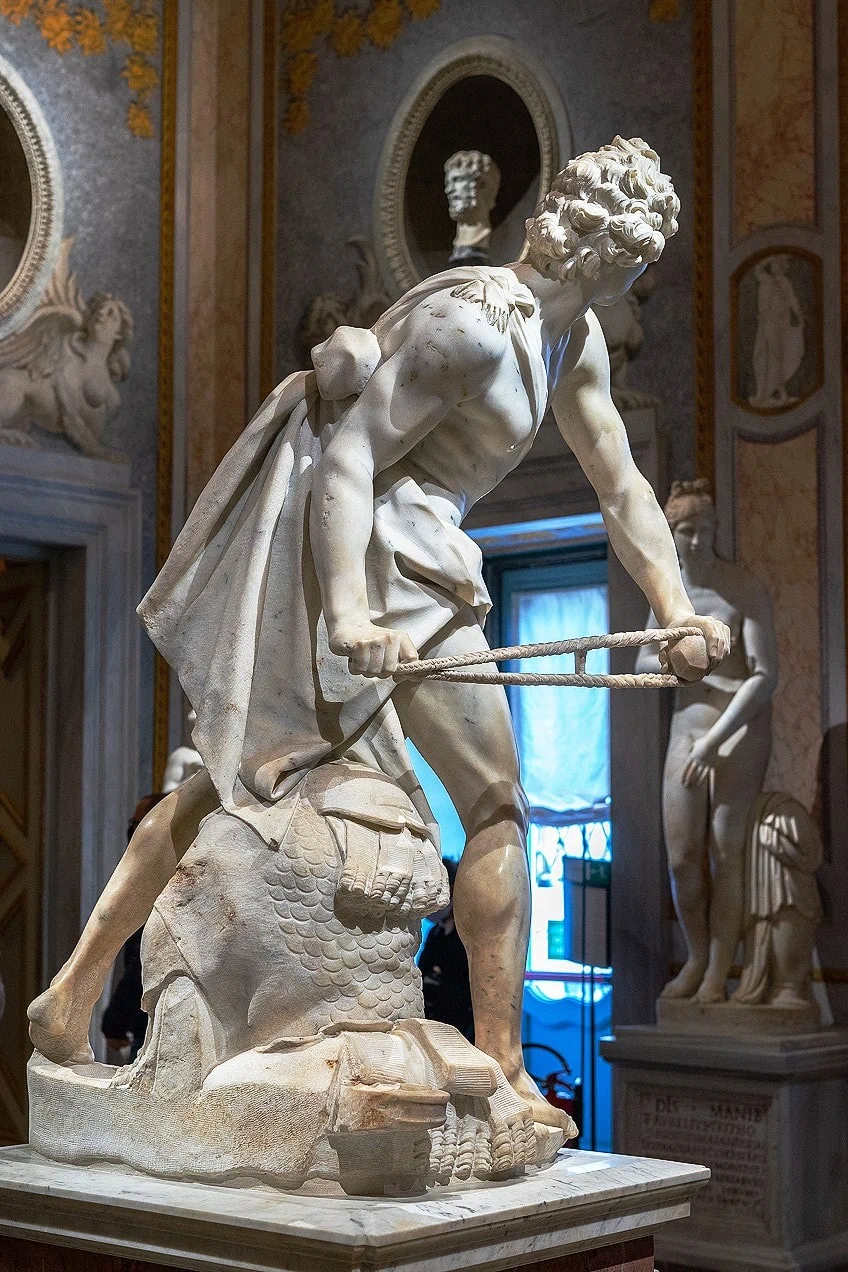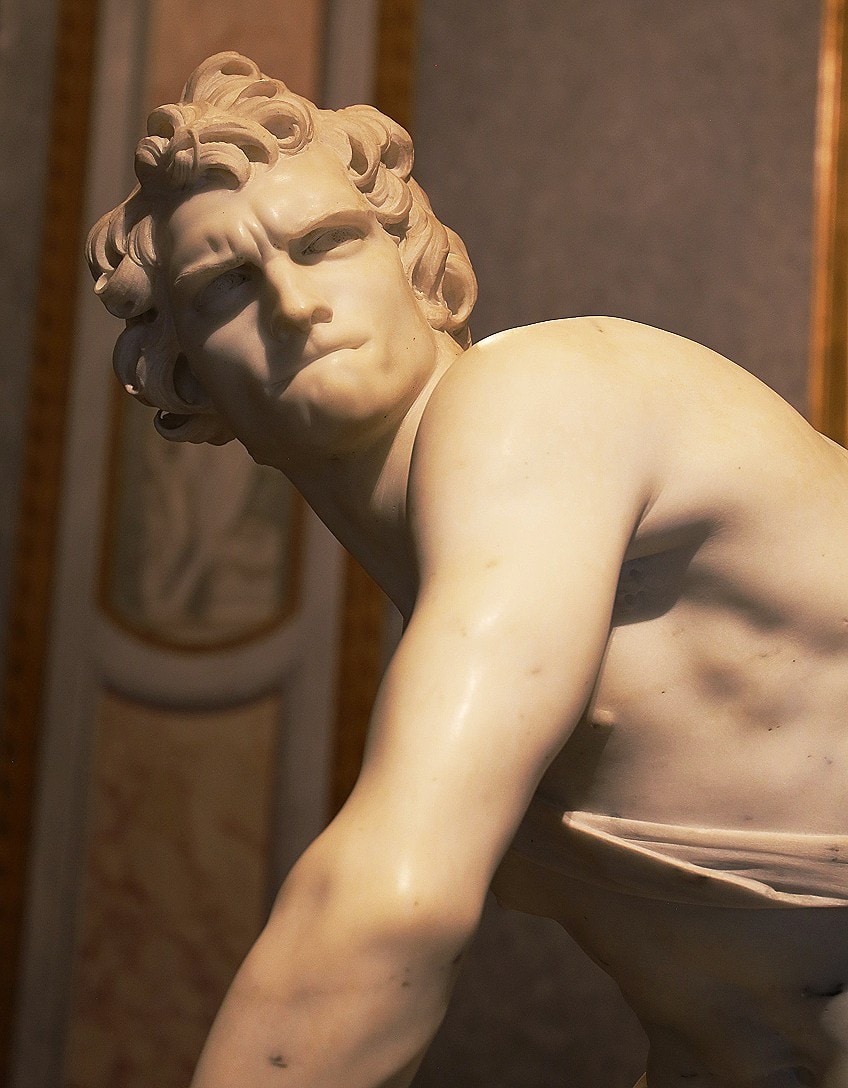“David” Sculpture by Bernini – Analyze Gian Lorenzo Bernini’s Work
We have all, at some point, come across biblical references in art. This article draws attention to one of the most iconic art pieces inspired by a biblical event. Below, we will take a closer look at the famous David sculpture by Gian Lorenzo Bernini and unpack its significance and design.
The David Sculpture by Gian Lorenzo Bernini
| Date | c. 1623 – 1624 |
| Medium | Marble |
| Dimensions (cm) | 170 (h) |
| Where It Is Housed | Galleria Borghese, Rome, Italy |
| Movement | Religious sculpture, Baroque |
If you are familiar with the Bible, then you are familiar with the narrative around David and Goliath. Inspired by the story, Italian architect and sculptor Gian Lorenzo Bernini was moved to create what we know of today as one of the most famous sculptures in the world.
Forming part of Galleria Borghese’s existing collection, David (1623 – 1624) is a life-sized sculpture of the biblical character, David, who was tasked with bringing down the giant, Goliath, using a stone.

The David sculpture by Bernini shows David in motion while throwing the stone. Bernini’s rendition of David in motion is what set his sculpture apart from Michelangelo’s version of David. But before we go on to discuss the significance and design of Bernini’s David, we will first look at the famous Italian artist himself, in the context of his sculptural practice.
Who Is Gian Lorenzo Bernini?
| Artist Name | Gian Lorenzo Bernini (also known as Gian Lorenzo Bernini) |
| Date of Birth | 07 December 1598 |
| Date of Death | 28 November 1680 |
| Movements | Baroque style, Italian Renaissance art, Mannerism, religious art |
| Mediums | Sculpture, painting, architectural design |
| Most famous works | ● Damned Soul (c. 1619) ● Bust of Pope Paul V (c. 1621 – 1622) ● Abduction of Proserpina (1621 – 1622) ● Bust of Costanza Bonarelli (c. 1630) ● Two Busts of Cardinal Scipione Borghese (1632) ● Truth Unveiled by Time (c. 1645 – 1652) ● Ecstasy of Saint Teresa (1651) ● Bust of Louis XIV (1665) ● Bernini Self-Portrait (c. 1665) |
Born in December of 1589, Gian Lorenzo Bernini was one of the most important Italian architects in the history of architecture. Recognized as the “leading sculptor of his era”, the reputable artisan was famous for his unique sculptural style called Baroque sculpture. At one point he was even compared to Shakespeare in reference to his mastery over the medium.
Bernini was not only a master of sculpture and architecture; this multi-talented man was also a painter, actor, scriptwriter, set designer, and director for satire plays. Talk about a man of all trades!
Design ran in his veins and Bernini also had his designs featured in many art objects, including coaches. His impressive portfolio kept growing and his architectural designs soon became part of city planning for the construction of religious buildings, public squares, and various monuments and temporary structures. His flexibility was greatly admired and so was his skill for using marble in sculpture. He was indeed a star in his own play.

But how did such a talented artisan emerge? From the young age of eight, Bernini was considered a child prodigy and received ongoing encouragement from his father. The young Bernini went on to earn much praise from influential patrons of the time who even likened his display of talent to that of Michelangelo.
Pope Paul V was also a fan, prophesying that “he will be the next” Michelangelo. With all the encouragement from individuals in such high positions, it was very likely that the young Bernini was destined for success.
The year 1606 was important since Bernini’s father was commissioned by the papacy to work on a marble relief at Santa Maria Maggiore. This required the entire Bernini family to relocate to Rome and this was to be one of the crucial moments of training for the young Gian Lorenzo.
Rise to Prominence
The reputation of the young Gian Lorenzo Bernini skyrocketed through his partnership with one of the largest Cardinals in Italy, Scipione Borghese. Bernini began working under the patronage of the Cardinal, delivering smaller decorative sculptures for the Villa Borghese. By his early twenties, the young Bernini had already amassed enough recognition to earn a commission for the Bust of Pope Paul V (1618), now housed at the J. Paul Getty Museum.
Since then, his rise to fame was guaranteed and he was considered almost incomparable to any master of sculpture.
David: A Baroque Masterpiece
Among his masterpieces, Aeneas, Anchises, and Ascanius (1619), The Rape of Proserpina (1621–1622), and Apollo and Daphne (1622–1625), all of which are on exhibit at the Galleria Borghese. Bernini’s David sculpture is one of four sculptures executed with such dramatic flair, typical of the Mannerist sculpture period in Renaissance sculpture. In conjunction with the Baroque style, Bernini created a new depiction of religious sculpture and this can be noted in David.
Bernini strategically utilizes the distinct dramatic approach to Realism in David, technically embedding every ounce of imagined emotion possible into the sculpture.
When you view Bernini’s David sculpture, you not only view a marble representation of the character but you also view the scene. The action displayed in the strain of David’s muscles, his facial expression, and his twisting motion, in preparation for taking down Goliath, is what makes this sculpture effective and unique to that of a standard representation of a still figure.

What is the statue of David holding? you may ask. Bernini brings to life the biblical scene of David throwing a stone. According to the legend, David was a key figure of power and heroism who defeated the giant Goliath by using a makeshift slingshot to throw a stone and bring the creature down for beheading.
It has been reported that Bernini embarked on a period of study prior to sculpting David, indeed taking his research into the Bible narrative and artworks made by other artists very seriously.
This was fitting research for the time given that this particular account was a common source of inspiration and subject matter for many Renaissance artists. Another reason for the artist’s motivation was possibly that all other great artists like Michelangelo, Donatello, and Verrocchio had all already sculpted their own versions of David, so it was necessary that the upcoming legend of architecture take on the challenge.

Bernini excelled in his depiction of David simply due to his originality and approach to the perspective. Many artists would have captured David, as seen through the lens of his legacy – as a hero, commemorated posthumously. Bernini on the other hand decided to bring David to life – to bring the defining moment in the character’s heroic act, to life.
The David sculpture by Bernini took several months to complete as Bernini applied his technical prowess in depicting David’s muscle movement, mental tension, and dynamics.
It was not David under construction, rather it was the battle. Cast your attention to David’s face. His features are sculpted with so much detail and intention to the emotional aspects of David’s expression. The intensity of his expression is found in David’s frown, bitten lips, serious demeanor, and his body – completely focused on the task and aim toward the enemy, Goliath. It was allegedly said that Maffeo Barberini, a close friend of Bernini, held up a mirror to assist Bernini in developing David’s classic grimace.

Bernini’s production received a lot of attention and attracted many spectators. The presence that emanated from the David sculpture allowed viewers to not only admire, as they would any other sculpture, but also preempt what David’s action implied and therefore know the consequence of David throwing the stone, as described in the biblical passage.
Bernini possessed such a strong grasp of technique and mastery over motion as seen in the human form, that he was seen as an artist who was “rivaled by only the greatest classical antiquity sculptors”. David is a perfect example of a sculpture by an artist who displayed a talent for both animate and inanimate subjects through grandeur, emotion, research, and willing hands.
Frequently Asked Questions
What Does Bernini’s David Refer To?
Bernini’s David refers to the life-sized marble sculpture made by Gian Lorenzo Bernini from 1623 to 1624 and is based on the biblical story of David and Goliath.
What Is the Statue of David Holding?
The statue of David is holding a sling band with a stone on the inner side of the band, acting as a weapon to take down the giant, Goliath.
What Is the David Statue’s Height?
The height of the David statue by Bernini is approximately 170 cm tall.
What Does the David Statue Represent?
The David statue represents the heroism displayed by the biblical character, David, when he slung a stone at the giant Goliath, which contributed to his triumph. The David statue is a tribute to the character and served as an icon for many Renaissance artists.
Where Is the David Sculpture by Bernini Housed?
The sculpture of David by Gian Lorenzo Bernini can be found at Galleria Borghese, as part of the Borghese collection, situated in Rome in Italy.
What Does Baroque Style Mean?
The Baroque style referred to in the article in reference to the Italian Renaissance artist describes the 18th and 17th styles of sculpture and is considered a movement defined by the presence of multiple viewing angles aimed at enhancing the viewer’s experience. This type of sculpture could be placed anywhere in an open space and the viewer would still be able to view a complete angle of the sculpture.
Jordan Anthony is a Cape Town-based film photographer, curator, and arts writer. She holds a Bachelor of Art in Fine Arts from the University of the Witwatersrand, Johannesburg, where she explored themes like healing, identity, dreams, and intuitive creation in her Contemporary art practice. Jordan has collaborated with various local art institutions, including the KZNSA Gallery in Durban, the Turbine Art Fair, and the Wits Art Museum. Her photography focuses on abstract color manipulations, portraiture, candid shots, and urban landscapes. She’s intrigued by philosophy, memory, and esotericism, drawing inspiration from Surrealism, Fluxus, and ancient civilizations, as well as childhood influences and found objects. Jordan is working for artfilemagazine since 2022 and writes blog posts about art history and photography.
Learn more about Jordan Anthony and about us.
Cite this Article
Jordan, Anthony, ““David” Sculpture by Bernini – Analyze Gian Lorenzo Bernini’s Work.” artfilemagazine – Your Online Art Source. August 10, 2022. URL: https://artfilemagazine.com/david-sculpture-by-bernini/
Anthony, J. (2022, 10 August). “David” Sculpture by Bernini – Analyze Gian Lorenzo Bernini’s Work. artfilemagazine – Your Online Art Source. https://artfilemagazine.com/david-sculpture-by-bernini/
Anthony, Jordan. ““David” Sculpture by Bernini – Analyze Gian Lorenzo Bernini’s Work.” artfilemagazine – Your Online Art Source, August 10, 2022. https://artfilemagazine.com/david-sculpture-by-bernini/.



